In case your clients are under the impression the ADA is not being enforced, here are a few examples of results obtained through either litigation, mediation, or negotiation.
- In Eastpointe, MI, the U.S. Attorney's Office for the Eastern District of Michigan reached a settlement agreement with the City of Eastpointe resolving a complaint that the newly constructed Thirty-Eighth District Courthouse was not accessible to persons with disabilities. Among other corrections, the municipality has agreed to make structural changes to the courthouse, including converting the north entrance to an accessible entrance with accessible parking, and modifying or replacing exterior routes and curb ramps.
- In Missouri an individual with a mobility disability complained that two shopping centers in Missouri did not have adequate accessible parking and accessible curb ramps. The owner of the shopping centers agreed to make modifications to its parking lots and curb ramps to provide accessibility.
- In New Hampshire an individual with a mobility disability complained that a food market lacked accessible parking. The market agreed to add two accessible parking spaces to its lot, including one van-accessible space, and to create an unobstructed accessible route from the parking spaces to the sidewalk.
- In Tennessee an individual with a mobility impairment complained that several commercial properties, including a bank, an office park, and a shopping center, all lacked adequate van-accessible parking in their parking lots. Each of these properties has since taken steps to provide accessible parking. Compliance reviews of six other commercial properties including an eye care center, two banks, a credit union, a tractor dealership, and the office of a public utility, revealed that all of these properties lacked adequate van-accessible parking. Each property has since restriped its parking lot in order to provide the required number of van-accessible parking spaces.
- In Oklahoma, a wheelchair user alleged that a courthouse was inaccessible. The courthouse installed an accessible route from its accessible parking spaces to the entry door.
For the most part the Dept. of Justice and other local, state, or federal enforcing bodies try to work with offending properties to bring them into compliance. The reason is not only that mediation and negotiation are less costly but also because the goal of the ADA guidelines and standards is to make facilities accessible to all citizens, not to fine property owners for non-compliance. So as long as the property owner has made or is making a good faith effort to bring properties into compliance, the government entities will work with him. In extreme cases, however the government has brought suit and the result being forced compliance as well as financial penalties.




















